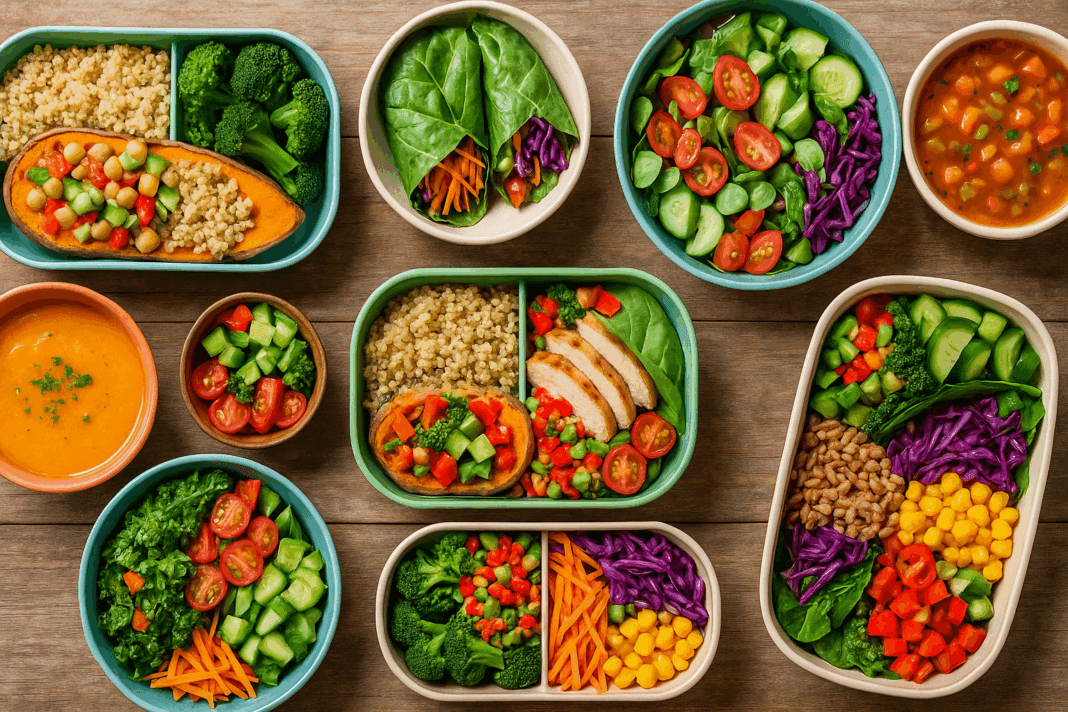Lunch is one of the most important meals of the day—it fuels the body and mind for the afternoon ahead. Yet, many people rely heavily on sandwiches, wraps, and other bread-based meals that may not always provide the best nutritional value. While convenient, these options often lead to bloating, energy crashes, and missed opportunities for greater variety in your diet. Fortunately, an increasing number of health-conscious individuals are turning to non bread lunch ideas that are not only delicious and diverse but also support better digestion, stable energy, and overall well-being.
Choosing ideas for lunch without bread doesn’t mean giving up satisfying meals. On the contrary, it opens the door to a new world of creative and wholesome eating. From protein-packed grain bowls and nutrient-rich salads to savory soups and veggie wraps, bread-free lunches can be just as filling—if not more so—than their doughy counterparts. With the right ingredients and preparation, these meals provide the perfect balance of protein, fiber, healthy fats, and complex carbohydrates, all while avoiding the heaviness that bread often brings.
You may also like: Smart, Simple Recipes for a Balanced Diet: Expert-Backed Healthy Food Dishes to Support Everyday Wellness
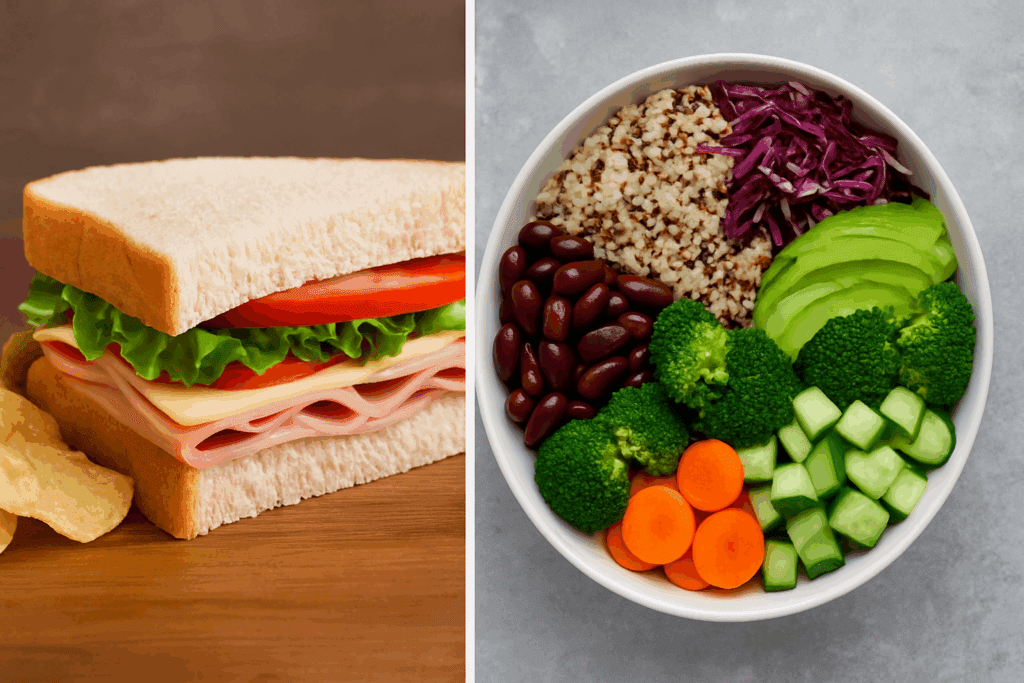
Why Many Are Skipping Bread at Lunch
Bread has long been a dietary staple, but for some, it’s more of a hindrance than a help. For individuals with gluten sensitivities, autoimmune issues like celiac disease, or simply those trying to limit refined carbohydrates, bread can contribute to bloating, sluggishness, and even skin flare-ups. Additionally, many store-bought breads contain added sugars, preservatives, and low-quality oils that don’t support optimal health. Even so-called “whole grain” breads can fall short nutritionally due to heavy processing and low fiber content.
By seeking out non bread lunch ideas, people are often able to improve their digestion and feel lighter throughout the day. Research shows that diets higher in fiber and lower in refined carbohydrates are linked to better metabolic health, more stable blood sugar levels, and a reduced risk of chronic disease. Shifting away from bread-based lunches encourages the inclusion of whole food ingredients that offer more nutritional density per bite.
It’s also worth noting that removing bread from the midday equation can introduce more variety into one’s eating habits. Without the fallback of a sandwich, meals often become more colorful, plant-forward, and rich in textures and flavors—qualities that make eating healthier feel like a reward, not a restriction.

Building a Balanced Bread-Free Bowl
Grain bowls are one of the most adaptable and satisfying ways to enjoy a bread-free lunch. These bowls typically include a whole grain base like quinoa, brown rice, or farro, topped with a variety of vegetables, legumes, and a lean protein. Healthy fats such as avocado, seeds, or tahini dressing add flavor and fullness, while herbs and spices round out the dish with vibrant taste.
For instance, a Mediterranean-inspired bowl with quinoa, chickpeas, roasted red peppers, olives, cucumber, and a lemon-tahini dressing is packed with fiber, plant-based protein, and heart-healthy fats. Similarly, a Mexican-style bowl featuring black beans, sweet potatoes, corn, and guacamole over brown rice provides sustained energy and a boost of antioxidants.
These non bread lunch ideas are perfect for meal prep, allowing you to prepare several servings in advance and customize them with different toppings throughout the week. The variety of combinations ensures you never get bored while still meeting your nutritional goals. These meals are filling, travel well, and are easy to store—making them ideal for work, school, or home.
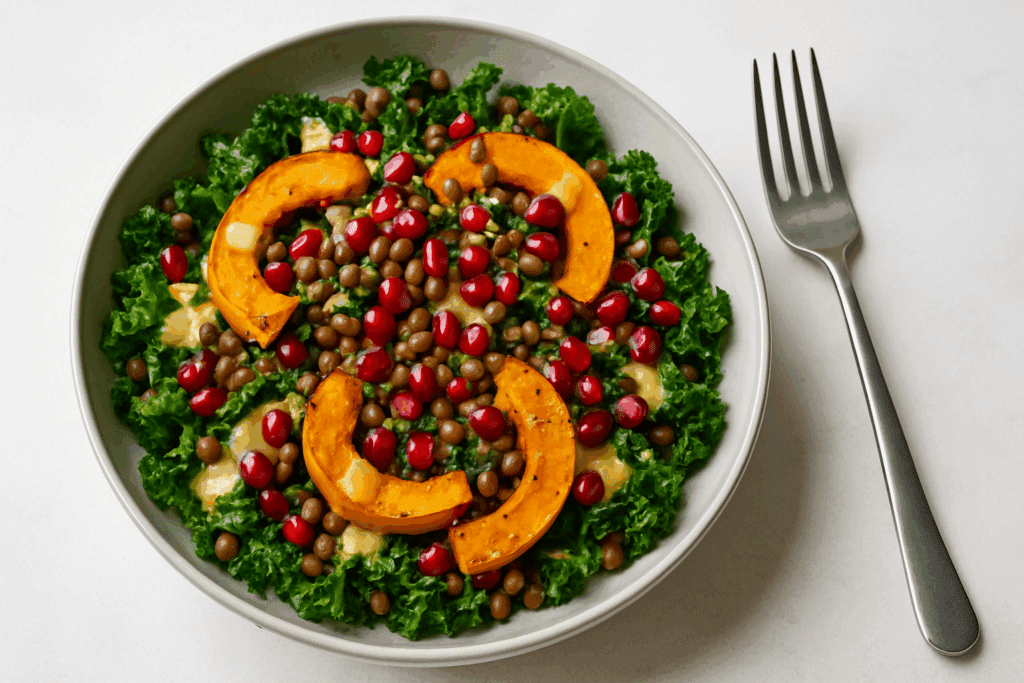
Salads That Satisfy Without Bread
Salads have come a long way from the bland side dishes of the past. Today, a salad can be a hearty, stand-alone lunch that hits all the major nutritional notes. The secret is to go beyond iceberg lettuce and embrace a wide range of colorful vegetables, legumes, fruits, grains, and proteins.
Take, for example, a kale salad with roasted butternut squash, lentils, pomegranate seeds, and a maple-Dijon dressing. It’s sweet, savory, and filling, offering ample fiber and plant-based protein. Or consider a grain-enhanced salad with arugula, farro, grilled chicken, cherry tomatoes, feta, and olives for a satisfying Mediterranean spin.
These salads make excellent non bread lunch ideas because they offer nutrient density without the post-meal heaviness that bread can bring. By focusing on texture, flavor balance, and a mix of macronutrients, you can build a salad that keeps you full for hours and delivers essential vitamins and minerals with every bite.
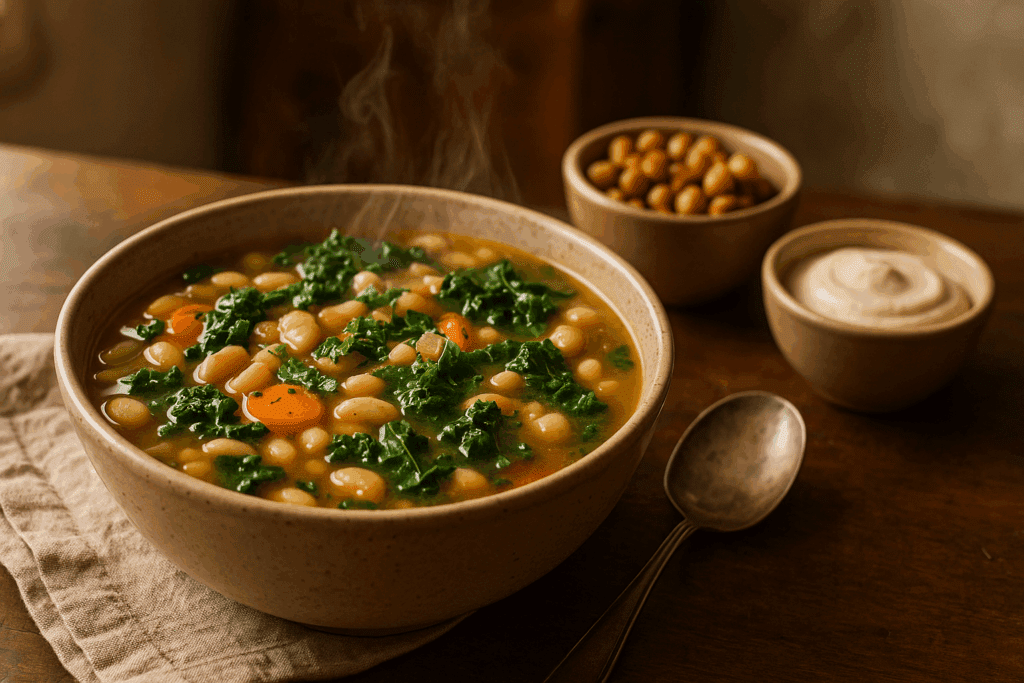
Soups and Stews as Hearty Alternatives
Soups and stews are often overlooked as main meals, but they can be some of the most satisfying ideas for lunch without bread—especially when packed with vegetables, legumes, and high-quality proteins. A bowl of soup can be warming, comforting, and deeply nourishing without needing a side of bread to make it feel complete.
For example, a white bean and vegetable stew with kale, carrots, and a touch of rosemary delivers fiber, iron, and immune-boosting antioxidants. Lentil soup with turmeric, garlic, and spinach supports digestion and reduces inflammation. These meals can be made in large batches, stored in the fridge or freezer, and easily reheated for a quick and nutritious lunch.
To elevate the meal further, consider adding toppings like roasted chickpeas, a swirl of cashew cream, or chopped fresh herbs. Not only do these additions provide flavor and texture, but they also contribute important nutrients that promote satiety and metabolic health. In this way, soups become more than just comfort food—they become smart, bread-free meal solutions.
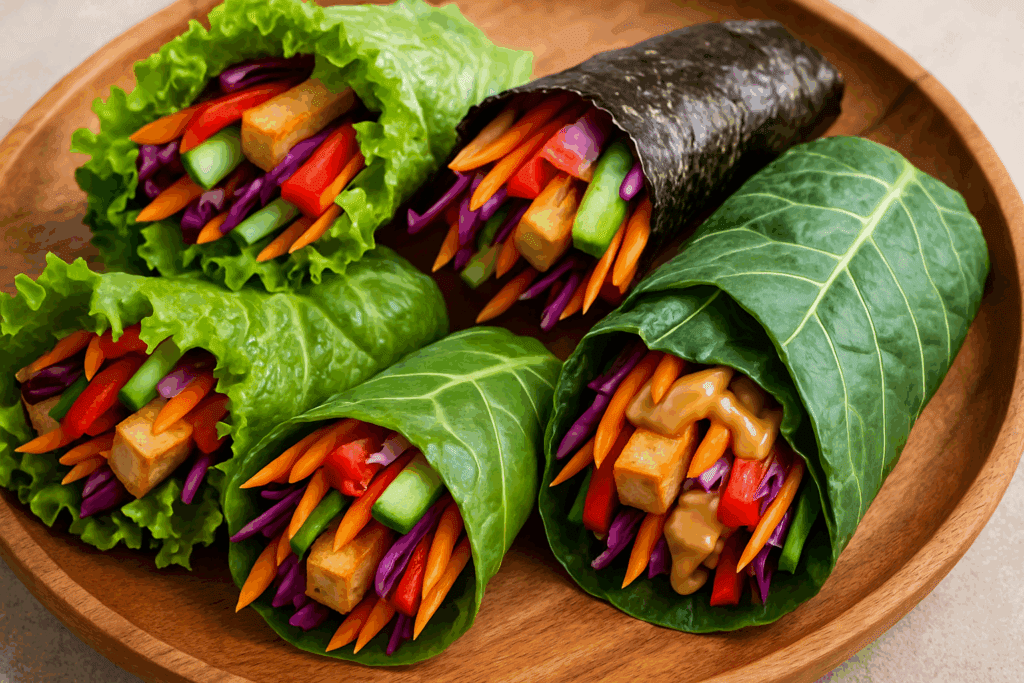
Wraps Without the Wheat: Lettuce, Nori, and Collard Creations
If you miss the convenience of handheld lunches but want to avoid bread, there are plenty of nutritious wrap alternatives that deliver both portability and taste. Large leafy greens like romaine lettuce, collard greens, or Swiss chard can serve as sturdy, nutritious vessels for all kinds of fillings.
Lettuce wraps filled with seasoned tofu, shredded carrots, avocado, and a drizzle of spicy peanut sauce offer a satisfying crunch and protein punch. Collard wraps can hold hummus, roasted vegetables, and grilled tempeh, creating a vibrant and portable lunch. Nori sheets, typically used in sushi, can be filled with rice, veggies, and smoked salmon for a fresh, ocean-inspired roll.
These non bread lunch ideas are not only fun to assemble, but they also encourage more mindful eating. The textures and flavors are engaging, and the meals are often lower in calories and carbohydrates—making them ideal for those managing weight or blood sugar. Plus, they’re naturally gluten-free and easy to personalize.
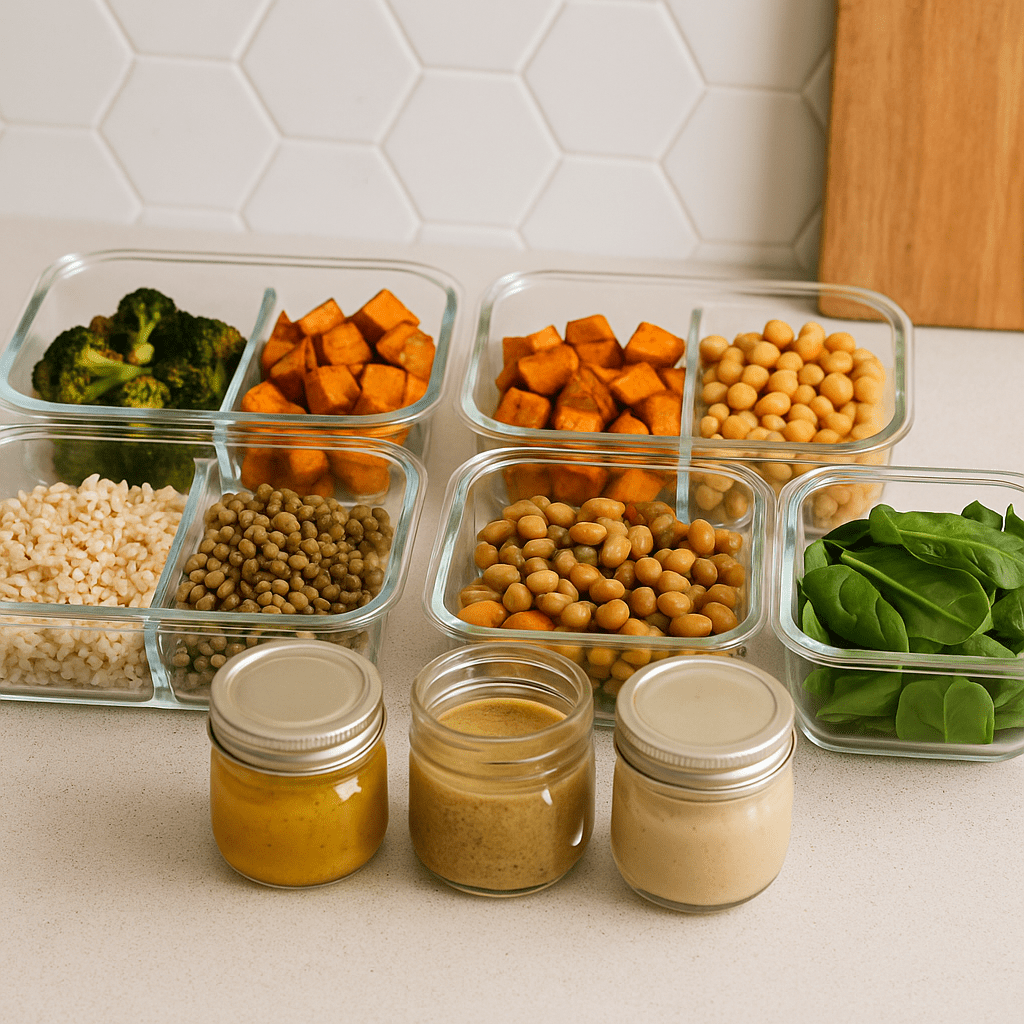
Meal Prepping for Bread-Free Success
Adopting a bread-free lunch lifestyle doesn’t require more time—it just requires a bit of smart preparation. With a few simple strategies, you can make your midday meals just as convenient as grabbing a sandwich, but far more nutritious and satisfying.
Start by batch cooking grains, proteins, and vegetables at the beginning of the week. Prepare components like baked tofu, roasted chickpeas, sliced vegetables, and dressings ahead of time. Store these ingredients in separate containers so you can quickly assemble salads, bowls, or wraps on busy days. This kind of preparation ensures that your non-bread lunch ideas stay fresh, diverse, and easy to put together.
Glass containers with dividers or bento boxes make it easy to transport and store bread-free meals. They also encourage portion control and help you avoid the temptation to reach for less healthy options when time is tight. With a little foresight, bread-free lunches can become your favorite part of the day.
How Going Bread-Free May Improve Digestion and Energy
Many people notice improved digestion and more stable energy when they reduce or eliminate bread from their lunch routines. Bread—especially the refined kind—can be difficult to digest for some, leading to bloating, gas, and fatigue. Gluten, yeast, and certain additives may also contribute to brain fog or skin issues in sensitive individuals.
By replacing bread with nutrient-dense vegetables, legumes, whole grains, and healthy fats, people often experience more sustained energy and fewer cravings. These foods digest more slowly and provide a steadier release of glucose, preventing the post-lunch energy slump that often accompanies bread-based meals.
Moreover, increasing dietary fiber through plants and legumes supports a healthy gut microbiome, which is linked to improved mood, immunity, and even cognitive performance. The shift to non bread lunch ideas isn’t just a dietary adjustment—it’s a full-spectrum upgrade to your wellness routine.
Frequently Asked Questions: Smart and Satisfying Non Bread Lunch Ideas
1. What are some overlooked pantry staples that support bread-free lunch planning?
Many people exploring ideas for lunch without bread overlook the powerful role pantry staples can play in building satisfying meals. Items like canned lentils, artichoke hearts, marinated mushrooms, sun-dried tomatoes, and jarred roasted red peppers can elevate non bread lunch ideas in seconds. These shelf-stable ingredients bring intense flavor and nutrition without the need for extra prep. For instance, combining canned lentils with sun-dried tomatoes and marinated artichokes over mixed greens creates a deeply savory salad that’s both portable and filling. Keeping these kinds of ingredients on hand not only saves time but also ensures that bread-free lunches can be just as flavorful and convenient as traditional options.
2. How can professionals with limited lunch prep time still enjoy non bread lunch ideas?
Busy professionals often default to sandwiches because they’re quick, but with a little strategy, there are equally convenient non bread lunch ideas. Batch-prepping three or four components—such as roasted veggies, cooked grains, a protein source, and a simple dressing—allows for mix-and-match lunches throughout the week. Mason jar salads and single-serving grain bowls are also effective, allowing for prep days in advance without sogginess or nutrient loss. For even faster solutions, store-bought items like pre-washed greens, vacuum-sealed tofu, or microwaveable quinoa can cut down assembly time to under five minutes. By investing just one hour each weekend, professionals can have several complete meals that support diverse and healthy ideas for lunch without bread.
3. Are there psychological or behavioral benefits to reducing bread consumption at lunch?
Beyond physical health, shifting to non-bread lunch ideas can support psychological well-being through increased mindfulness and food diversity. When bread is removed from the routine, individuals often become more intentional with their food choices, which can promote more mindful eating habits. Eating a wider variety of ingredients also reduces dietary monotony, which has been linked to better long-term adherence to healthy eating plans. This variety introduces new textures, flavors, and nutrients that keep meals exciting and reduce the psychological fatigue that often accompanies repetitive lunches. Over time, these small shifts can enhance the overall enjoyment of meals and build a stronger, more positive relationship with food—an important yet often overlooked aspect of health behavior change.
4. Can non-bread lunch ideas support athletes or highly active individuals?
Absolutely. Non bread lunch ideas can be tailored to meet the higher caloric and nutrient needs of active individuals and athletes. For example, a bowl made with farro, roasted chickpeas, avocado, sautéed spinach, and tahini dressing offers sustained energy, complete protein, and electrolyte-rich greens. Including calorie-dense but healthy fats—like nuts, seeds, and nut butters—can help increase energy intake without the bulk of bread. Ideas for lunch without bread can also focus on anti-inflammatory ingredients like turmeric, ginger, and dark leafy greens to support recovery and performance. With the right planning, bread-free meals can be an essential part of a performance-oriented lifestyle without sacrificing satiety or convenience.
5. What are some globally inspired non bread lunch ideas for adventurous eaters?
Globally inspired meals provide exciting and nutrient-rich ideas for lunch without bread. For example, Ethiopian injera can be replaced with lentil-based veggie stews served over sautéed greens. Korean bibimbap bowls, traditionally served with rice and a variety of pickled and sautéed vegetables, offer a vibrant bread-free experience that can be customized with tempeh, eggs, or tofu. Vietnamese spring rolls wrapped in rice paper and filled with herbs, vermicelli, and vegetables make another great option. Mediterranean mezze-style lunches with hummus, grape leaves, cucumber salad, and falafel balls also offer an engaging non bread experience. Drawing inspiration from global cuisines expands your palate and provides a broader spectrum of nutrients without relying on bread as a meal anchor.
6. How can someone transition to bread-free lunches without feeling deprived or unsatisfied?
A successful transition starts with focusing on flavor, texture, and variety—elements that many associate with satisfaction. Instead of cutting out bread abruptly, start by incorporating one or two non-bread lunch ideas per week. Use hearty ingredients like legumes, avocados, nuts, and roasted vegetables to build fullness and richness. If sandwiches are hard to give up, try recreating your favorite fillings in a lettuce wrap or bowl format to preserve familiar flavors. Over time, your taste preferences and digestive comfort may naturally guide you toward more ideas for lunch without bread, especially as you notice how these meals support more stable energy and fewer afternoon crashes.
7. Are non bread lunch ideas suitable for children or picky eaters?
Yes, with thoughtful preparation and presentation, non bread lunch ideas can be made appealing to children and selective eaters. Bento-style lunches with small compartments allow for visual variety and fun textures—hummus with veggie sticks, sliced fruit, rice balls, and roasted chickpeas are all kid-friendly and bread-free. Involving children in the prep process can also increase their willingness to try new foods, as autonomy and exposure build food familiarity. Smooth transitions, like swapping sandwich bread for a tortilla or large lettuce leaf, also ease the adjustment. For families seeking healthier school lunches, investing in a thermos for warm soups or a leak-proof container for quinoa salads can turn these ideas for lunch without bread into delicious and reliable staples.
8. How do non bread lunch ideas align with sustainable or eco-friendly eating practices?
Many non-bread lunch ideas naturally align with sustainable eating due to their emphasis on whole, plant-based ingredients. Meals built around legumes, seasonal produce, and whole grains tend to have a lower carbon footprint than those centered around processed bread products and animal-based fillings. Additionally, preparing bread-free meals at home often reduces packaging waste, especially when using bulk ingredients and reusable containers. Compostable lettuce wraps, mason jars, and stainless-steel lunch boxes offer further environmental benefits. When paired with local, in-season vegetables and responsibly sourced proteins, these ideas for lunch without bread become not only healthier for the body, but also gentler on the planet.
9. Can non-bread lunch ideas support blood sugar management for individuals with diabetes or prediabetes?
Yes, many non bread lunch ideas are particularly beneficial for individuals managing blood sugar. Bread—especially white or refined varieties—can spike glucose levels quickly, leading to crashes and fatigue. In contrast, meals focused on fiber-rich vegetables, healthy fats, and lean proteins support steadier blood sugar control. A lentil salad with avocado and roasted peppers or a brown rice bowl with grilled tofu and vegetables delivers complex carbs that digest slowly. These meals are low on the glycemic index and support insulin sensitivity, making ideas for lunch without bread a smart choice for those seeking to stabilize energy and improve metabolic health over time.
10. What trends are shaping the future of bread-free lunch innovation?
The future of non bread lunch ideas is being shaped by several converging trends, including the rise of plant-based eating, functional ingredients, and personalized nutrition. Fermented foods like kimchi and miso are making their way into lunch bowls, providing gut health benefits and adding complex flavor. Meal delivery services are also offering more bread-free options that cater to specific diets, such as low FODMAP or Mediterranean. Technological advances in food prep tools—like portable steamers and smart lunch boxes—are making it easier than ever to prepare and enjoy ideas for lunch without bread, even on the go. As more consumers demand transparency, sustainability, and health in their meals, the range of bread-free innovations will likely continue to expand and evolve.
Conclusion: Redefining Lunch for Better Health and Satisfaction
Choosing to explore ideas for lunch without bread is more than a dietary preference—it’s a meaningful shift toward more mindful, nutrient-rich, and energizing eating. Bread-free meals are not only possible; they’re delicious, practical, and deeply satisfying. Whether you opt for a warm bowl, a colorful salad, a savory soup, or a vibrant veggie wrap, these non bread lunch ideas can enhance your health without compromising on taste or convenience.
For those seeking better digestion, balanced blood sugar, or simply more variety in their meals, bread-free lunches offer a fresh perspective. They encourage creativity in the kitchen, expand your flavor horizons, and support a lifestyle rooted in intentional nourishment. As more people discover the benefits of ditching the daily sandwich, it becomes clear that lunch can be so much more than bread.
By embracing whole foods, listening to your body, and preparing ahead, you can enjoy smarter and more satisfying midday meals every day. Say goodbye to the bread-based bloat—and hello to a healthier, more energized you.
Was this article helpful? Don’t let it stop with you. Share it right now with someone who needs to see it—whether it’s a friend, a colleague, or your whole network. And if staying ahead on this topic matters to you, subscribe to this publication for the most up-to-date information. You’ll get the latest insights delivered straight to you—no searching, no missing out.
healthy lunch ideas, gluten free lunch recipes, low carb lunch options, anti bloating meals, high fiber lunch ideas, plant based lunch inspiration, easy lunch meal prep, gut friendly lunch recipes, dairy free lunch alternatives, whole food lunch options, lunch without refined carbs, low glycemic lunch recipes, energizing midday meals, balanced lunch bowls, nutritionist approved lunches, mindful eating meals, vegetable based lunch dishes, healthy protein lunch ideas, weekday lunch without bread, nutritious lunch box ideas
Further Reading:
70 Healthy Lunch Ideas for Seriously Delicious Midday Fuel
15 Easy Lunch Ideas That Nutritionists Actually Make
32 Healthy Lunch Ideas You Can Make in 10 Minutes
Disclaimer
The information contained in this article is provided for general informational purposes only and is not intended to serve as medical, legal, or professional advice. While NewsHealthWatch strives to present accurate, up-to-date, and reliable content, no warranty or guarantee, expressed or implied, is made regarding the completeness, accuracy, or adequacy of the information provided. Readers are strongly advised to seek the guidance of a qualified healthcare provider or other relevant professionals before acting on any information contained in this article. NewsHealthWatch, its authors, editors, and contributors expressly disclaim any liability for any damages, losses, or consequences arising directly or indirectly from the use, interpretation, or reliance on any information presented herein. The views and opinions expressed in this article are those of the author(s) and do not necessarily reflect the official policies or positions of NewsHealthWatch.

